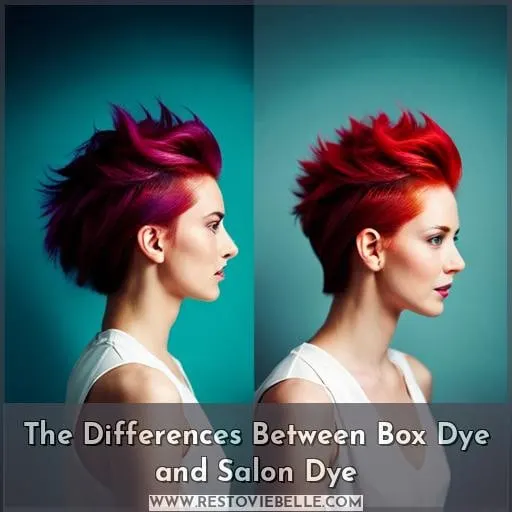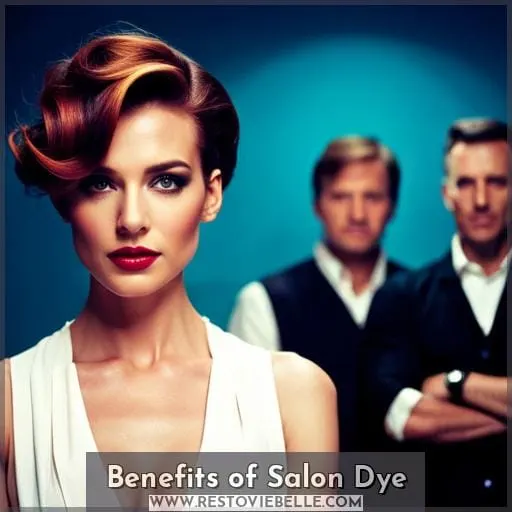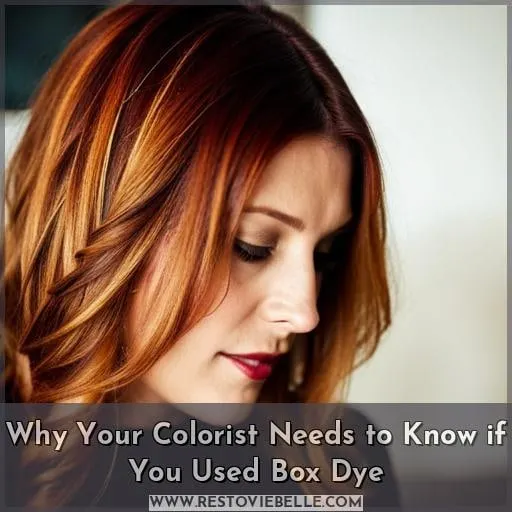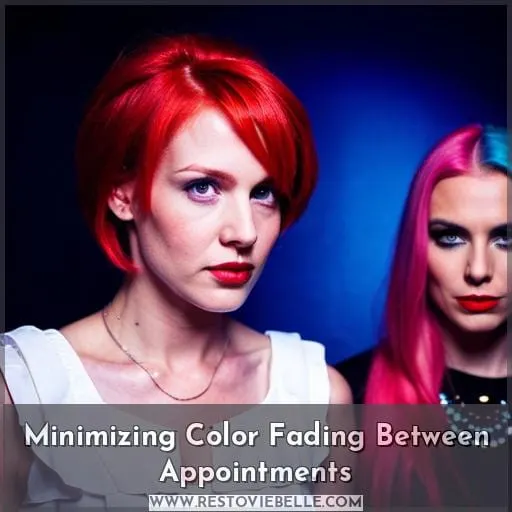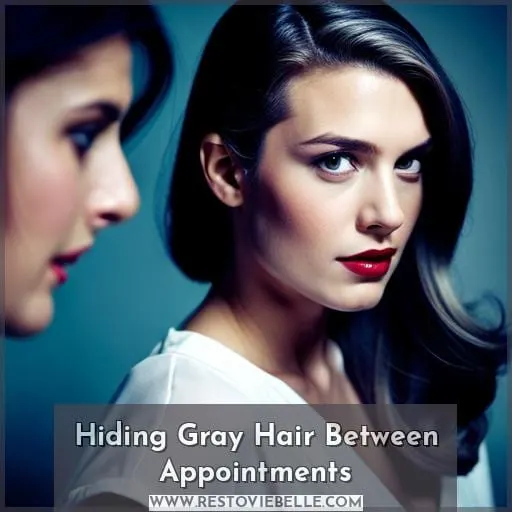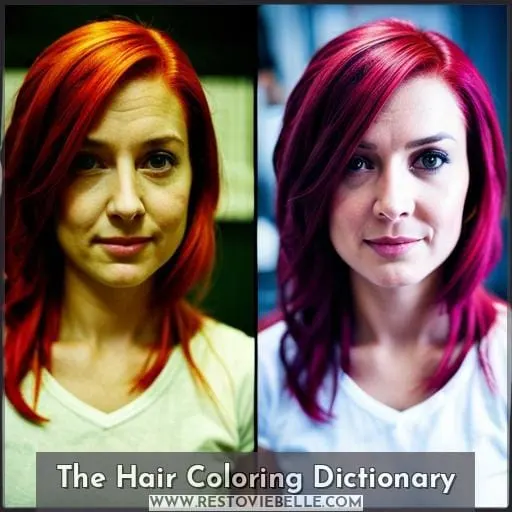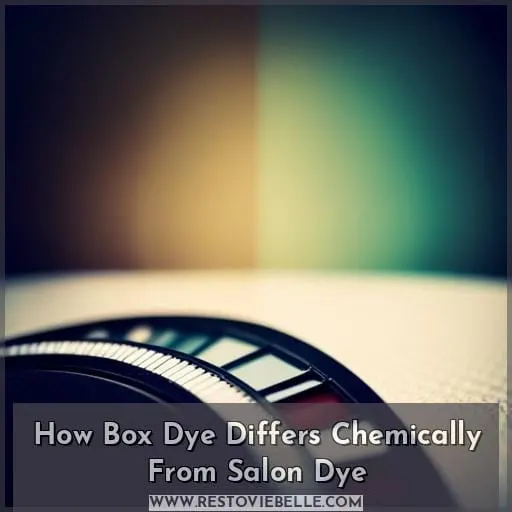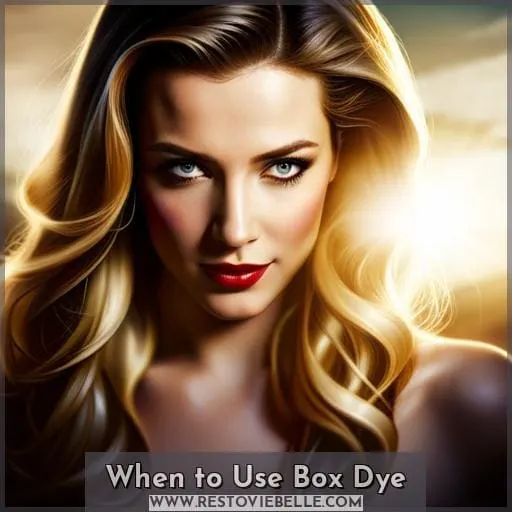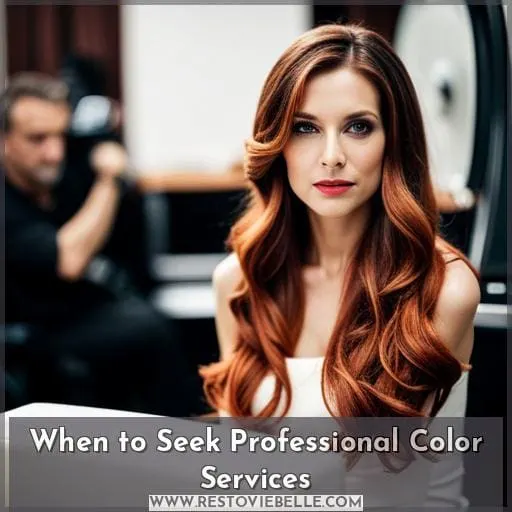This site is supported by our readers. We may earn a commission, at no cost to you, if you purchase through links.
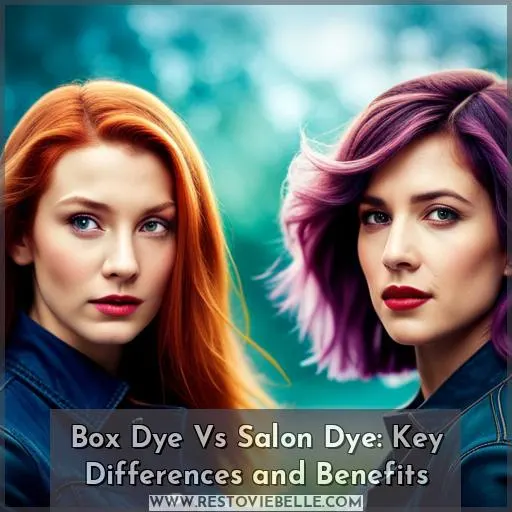
With this article, we’ll cover everything from box dye vs salon dye cost comparisons and benefits of using professional products to how these formulas differ chemically in order to help you determine which option is right for you.
So take some time before making any decisions so that when it comes time for coloring your locks, whether at home or in-salon, you can do so with confidence!
Table Of Contents
- Key Takeaways
- The Differences Between Box Dye and Salon Dye
- Benefits of Salon Dye
- Why Your Colorist Needs to Know if You Used Box Dye
- Minimizing Color Fading Between Appointments
- Hiding Gray Hair Between Appointments
- The Hair Coloring Dictionary
- How Box Dye Differs Chemically From Salon Dye
- When to Use Box Dye
- When to Seek Professional Color Services
- Conclusion
Key Takeaways
- Box dye is initially cheaper, but salon dye offers better long-term value and quality.
- Salon dyes are gentler on hair and use custom formulas, while box dyes often contain harsh chemicals.
- Box dyes may result in uneven or darkened strands, leading to costly corrections, while salon dyes offer predictable and uniform results.
- Salon dyes prioritize hair health, using techniques like foiling and balayage, and considering individual hair type and color history.
The Differences Between Box Dye and Salon Dye
Are you considering a new hair color? The decision between box dye and salon dye can be difficult, as there are differences in chemical composition and formula, cost comparison, and color/application challenges.
Box dyes often contain harsh chemicals like ammonia, while salon formulas tend to be gentler on the hair. Additionally, professional salons have access to products that aren’t available with drugstore brands, which makes for longer-lasting results but at a higher price point than what’s offered in stores.
Color application is also an important factor when choosing between box or salon dye.
Chemical Composition and Formula
When it comes to hair coloring, you should be aware of the differences between DIY box dye and salon-grade formulas when deciding which route is best for you. Professional color offers tailored, top-notch ingredients that will give your locks a luxurious makeover.
Box dyes are pre-made with harsh chemicals like ammonia and often lack consideration for individual hair type or health history. Salon formulas are gentler on hair, using custom colors created by knowledgeable professionals who can employ techniques such as foiling or balayage.
Cost Comparison
It’s important to consider the cost of box dye versus salon dye when deciding how you want your hair colored.
Box dyes are initially cheaper, but long-term costs can be high.
Professional color offers tailored, predictable results and is safer for hair health in the long run.
Quality ingredients differ significantly between box and salon dyes. Professional brands prioritize higher quality production over a one-size-fits-all approach with box dyes. Box dyes often contain harsh chemicals like PPD or ammonia, which can damage hair more easily than their gentle counterparts used in salons.
DIY highlights may result in uneven or blackened strands. Costly color corrections require visits to a pro if mistakes occur during at-home coloring sessions.
Consider both initial costs as well as potential future expenses before making any decisions about your mane!
Color and Application Challenges
Color-matching can be difficult with box dyes, as they do not take individual hair type and color history into account. Box dye formulas often contain harsh chemicals like metallic salts that damage the hair cuticle over time, leading to fading.
While professional colorists use application techniques such as foiling or balayage for better coverage and longevity, these are not possible with DIY kits.
Benefits of Salon Dye
Are you considering a new look for your hair? Box dye and salon dye are two popular options, but there is an essential difference between them: customized formulas created by professional colorists that consider individual hair type, health, and color history.
Professional techniques such as foiling or balayage can also be used to create detailed designs with salon dyes; box dyes do not offer this same level of customization.
Customized Formulas
Customizing formulas to suit your individual hair type, health, and color history ensures you receive the best possible results from a professional salon dye. Benefits include: 1) customized formulas; 2) hair health protection; 3) salon-grade quality ingredients; 4) expert colorist consultation; 5) a unique chemical composition for optimal results.
Professional dyes offer superior coverage, vibrancy, and longevity compared to box dye – liberating you from the hassle of constantly retouching or correcting mistakes.
Professional Techniques
From foiling and balayage to babylights and dip-dye, professional colorists can use a range of techniques to create your desired look. Hand-painted balayage offers vibrant highlights without the harsh lines of foil placement.
Color correction tips are vital when dealing with box dye mistakes; hair health maintenance is key for lasting results.
Consideration of Hair Health
When it comes to hair color, considering the health of your locks is essential. Opting for salon dye over box dye allows for the consideration of chemical concerns and haircare tips, as professionals use ammonia-free hair colors that are gentler on your tresses while also reducing environmental impact.
Professional colorists can provide customized results tailored specifically to individual needs and history, with minimal risk of damage.
Why Your Colorist Needs to Know if You Used Box Dye
It is essential for your colorist to know if you have used box dye, as it can lead to potential reactions and incompatibilities that must be addressed. Your stylist will also need to employ corrective measures in order to achieve the desired hair color result or perform a necessary color correction.
Therefore, being honest about any box dye use is key to achieving successful salon results.
Potential Reactions and Incompatibilities
It’s important for your colorist to know if you’ve used box dye, as reactions and incompatibilities between different dyes can cause further damage or discoloration. Potential allergies, chemical reactions, and color clashes could all be avoided with a patch test beforehand.
Safety should always come first when it comes to home hair coloring; expert suggestions are key for avoiding potential pitfalls of DIY treatments. When the stakes are high—such as bleaching or drastic changes—it is wise to call in the professionals who have experience dealing with such challenges safely and effectively.
The combination of quality ingredients offered by salons along with their expertise makes them invaluable partners in achieving desired results without sacrificing hair health.
Corrective Measures and Color Correction
If you’ve taken a DIY approach to color, your colorist may suggest corrective measures or even require a full-on correction job. Professional expertise is essential for successful hair transformations and comparisons between box dye and salon dye.
With the right corrective measures, your colorist can restore vibrancy while protecting the health of your hair from further damage caused by incompatible formulas.
Salon benefits like expert consultation and tailored formulations are key factors in achieving desired results without risking breakage or unevenness due to overuse of bleach or other harsh chemical components found in box dyes.
Minimizing Color Fading Between Appointments
Maintaining your salon hair color between appointments requires a diligent hair care routine and the right products. Investing in color-protecting shampoo and conditioner, avoiding hot tools whenever possible, and using temporary root concealers for gray coverage are all great ways to keep your look vibrant until you can return to the salon for another dye job.
Proper Haircare Routine
To maintain vibrant and healthy hair color, incorporate a diligent hair care routine into your regimen. Proper conditioning with color-protecting shampoos and conditioners helps provide gray coverage in between appointments, while heat protection products help keep your locks looking luscious.
Don’t forget to take special care of the scalp too! Investing in quality hair care blog advice or visiting a salon for after-care advice can make all the difference when it comes to box dye vs salon dye decisions.
Color-Protecting Products
Protective products are essential to maintain your vibrant salon dye between appointments – A stitch in time saves nine. Color-preserving shampoos, fading prevention, color longevity, and brassiness control should be part of the hair care routine.
Heat protectants help preserve color too, and using a professional for box dyes will cut down on costs over time while ensuring maximum color maintenance.
Temporary Root Concealers
When it comes to taking care of your hair between salon visits, temporary root concealers are a great way to help keep your color looking fresh and vibrant. They provide fast gray coverage without the risks associated with box dye or permanent applications.
Temporary solutions like Root Touch Ups can camouflage roots while giving you more time before needing another appointment for full coloring.
Hiding Gray Hair Between Appointments
Between salon appointments, you can help hide gray hair with the use of temporary root touch-up products and color-depositing shampoos. These products are designed to keep your hair looking vibrant for longer periods of time, so you don’t have to worry about fading or graying roots in between trips to the salon.
Color-Depositing Shampoos
For a quick touch-up between appointments, try color-depositing shampoos to help maintain your desired shade. Color maintenance and brassiness prevention are key when hiding gray hair or extending the life of salon dye jobs.
Choosing the right shampoo is essential; opt for color-safe products with no sulfates or parabens that protect both the hue and health of your locks.
Root concealers can provide temporary coverage, while box dyes offer longer-lasting results. However, be aware that these formulas may damage your hair if used incorrectly. When considering gray coverage options, it’s important to look at professional salon colors and seek advice from experienced colorists.
This will ensure an even finish without any orange tones or overlapping bleach applications.
Temporary Root Touch-Up Products
Try a temporary root touch-up product that offers natural coverage to help bridge the gap between salon visits and keep your hair looking fresh – it’s like camouflage for gray roots!
From quick fixes to instant coverage, there are plenty of options when it comes to camouflaging grays. Root touch-ups provide an easy way to stay up on your color without having to go through a full hair dyeing process or booking another expensive appointment.
When deciding which concealer is right for you, be sure to consider if you’re using box dye vs salon dye and how often you need application so you can find the perfect match for your needs.
With these products in hand, even long gaps between appointments don’t mean sacrificing great-looking hair all year round!
The Hair Coloring Dictionary
Ready to turn heads with a new look? Why not try one of the trendiest hair coloring techniques like ombre, sombre, dip-dyed, highlights, or lowlights? These styles offer endless possibilities and can give you just the right touch of color.
Ombré
Discover the beauty of ombré! Create sun-kissed looks with effortless transitions between shades. Choose colors, maintain it, tailor it to your hair type—all without box dye or salon trips.
Sombre
Experience the softer side of ombré with sombre. A gradual blend of colors, like a sunset on your hair, it requires expert hairdressing experience to achieve the formula and process just right.
Dip-Dyed
Dip-dyed hair offers a vibrant contrast between colors, creating an eye-catching look that can be tailored to your individual style. Color maintenance and styling tips are essential for this unique technique. DIY mistakes should be avoided; salon expertise is key! Box dye and bleaching hair may cause irreversible damage—opt for highlights instead.
Highlights
Try out highlights for a subtle way to add depth and texture. Play with techniques like balayage, lowlights, frosting, or babylights. Maintenance is key; use color-protectant products and tools. Consider DIY highlighting options, but be careful! Choose colors that suit your hair goals and box dye versus salon dye preferences carefully.
Lowlights
Elevate your look with lowlights for a subtle yet eye-catching transformation! Achieve dramatic depth by adding darker tones to create contrast and shadows. Lowlights are less prominent than highlights, making them ideal for those wanting a natural look.
For maximum impact, use a heat protectant during the styling process and consider combining the technique with reverse balayage or babylights in medium hairdressing colors like copper or chocolate brown.
How Box Dye Differs Chemically From Salon Dye
If you are considering a hair color change, it is important to understand the key differences between box dye and salon dye. Box dyes often contain harsh chemicals and ammonia, which can damage your hair. On the other hand, salon formulas are gentler on hair and provide more precise results.
This is because they are custom-made formulations that take into account individual characteristics such as hair type, health history, or color goals. Additionally, professional colorists offer expertise in application techniques like foiling or balayage, which box dyes cannot provide.
Ingredient Quality and Safety
Comparing box dye and salon dye can be daunting, but understanding ingredient safety and quality standards is essential. Chemical concerns abound with box dyes, while professional formulations prioritize higher-quality production.
Harmful additives like metallic salts, PPD, ammonia, or peroxide can weaken the hair cuticle.
Uniformity and Predictability of Results
When it comes to achieving uniform and predictable results, box dyes cannot compare to salon formulas. Professional colorists use customized formulas based on hair health consideration and communication with the client.
Salon expertise ensures long-term consistent results not achievable through DIY dyeing methods. Customized colorant mixtures greatly reduce fading and ensure a desired outcome that reflects individual needs while maintaining healthy hair integrity over time.
Box Dye:
- Pre-made Formula
- No Expertise
- Unpredictable & Unreliable
- Uneven Application
- No After Care Advice
- High Cost of Corrections/Repairs
Salon Dye:
- Customized Formulas Based on Hair Health Consideration & Communication With Client
- Tailored Color Mixture Reduces Fading / Consistent Results
- Reflects Individual Needs While Maintaining Healthy Hair Integrity Over Time
- Uses Professional Expertise for Long Term Results That Are Not Achievable Through DIY Methods
- Predictable, Reliable Outcome
- Even Application by Professionals Assures Perfect Results Everytime
- Receive Aftercare Advice from Colorist
- Low Cost Repairs if Need Be
Quality Ingredients Lead To Excellent Outcomes!
Hair Damage and Longevity of Color
Considering the quality and ingredients of both types of dye, it’s important to be aware that box dyes may cause more hair damage over time. Box dyes are cheaper initially but don’t last as long or achieve uniform results; salon dye offers tailored, predictable, and safe color with aftercare advice.
When to Use Box Dye
When it comes to considering box dye vs salon dye, cost and convenience are key considerations. From temporary colors to experimentation, box dyes provide an accessible and affordable option for those looking for a quick fix or something new.
Understanding when to use them is essential in order to avoid hair damage or costly corrections down the line.
Cost and Convenience Considerations
When making a decision between box dye and salon dye, you’ll want to consider the cost and convenience of both. Table 1 shows that while box dyes are initially cheaper, long-term costs can be high due to color corrections or regular appointments.
The time factor is also an important one as DIY risks could easily lead to uneven results or blackened hair requiring professional attention afterward. Box dyes lack the application skills of salon colorists, so it’s important to weigh up affordability options with longevity in mind when deciding on a solution for your hair coloring needs.
Temporary or Experimentation Colors
If you’re looking to try out a new look without the commitment of a permanent color, box dyes can be great for experimentation and temporary transformation.
- Choose shades that complement your skin tone.
- Do an allergy test beforehand.
- Pick up some protective styling products before coloring.
- Follow instructions carefully and wear gloves when handling dye solutions!
- Use deep conditioners afterwards to keep hair healthy and hydrated.
With box dyes, it’s possible to get creative with different styles while keeping things low maintenance and affordable—perfect for those who want frequent changes without damaging their locks or breaking the bank!
When to Seek Professional Color Services
You may be considering a dramatic color transformation, but it’s important to understand the differences between box dye and salon dye. Complex color transformations are best achieved by professional colorists who can assess your hair type, health, and history in order to create custom-made formulas that won’t damage or weaken your hair.
Corrective coloring procedures also require skilled application, which is why seeking out an experienced hairdresser is recommended for maintaining both the integrity and health of your locks.
Complex Color Transformations
For complex color transformations, it’s worth booking a professional salon appointment and investing in quality ingredients for top results – just ask Evelyn Davies. Hair trends like ombre, sombre, balayage, or babylights require expertise to achieve the best look.
Consult with your colorist on hair health considerations before committing to a major change.
Corrective Color Procedures
Corrective color procedures are essential when you need to reverse the effects of a box dye job or fix color that turned out differently than expected. Color correction requires specialized techniques and expertise, so it’s best left to professional stylists.
Box dye challenges can be solved with corrective treatments such as re-dyeing, toners, and highlighting for desired results.
Maintaining Hair Health and Integrity
To maintain hair health and integrity, it is essential to choose a colorist who offers tailored solutions. It can be a daunting task, but one that can be rewarding! Hair maintenance tips, such as using cool water for washing, help increase color longevity.
Professional salons use quality ingredients with fewer chemical risks than box dyes offer.
Conclusion
It’s clear that there are many differences between box dye and salon dye, and it’s important to consider them before deciding which one to use. Box dye may be cheaper and more convenient, but it’s often made with harsher chemicals and can be difficult to apply evenly.
Salon dye, on the other hand, can be tailored to the individual and applied with more precise techniques, resulting in longer-lasting, more vibrant color. Ultimately, it’s best to consult with a professional colorist to determine what will work best for you and your hair.
With their expertise and the right product choices, you can achieve your desired look while keeping your hair healthy and vibrant.

